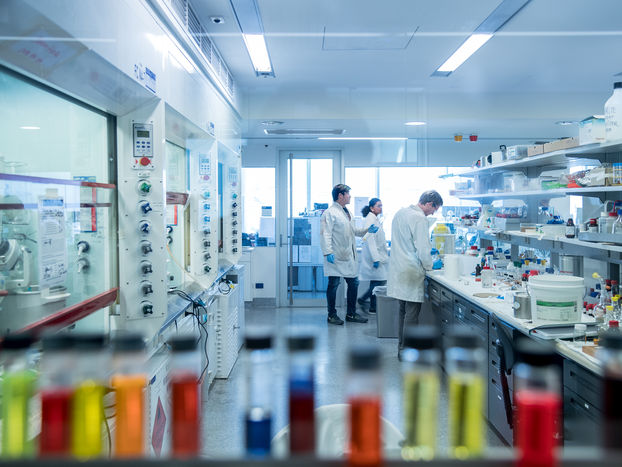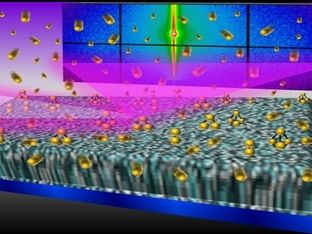World record broken for thinnest X-ray detector ever created
Highly sensitive and with a rapid response time, the new X-ray detector is less than 10 nanometres thick and could one day lead to real-time imaging of cellular biology
Scientists in Australia have used tin mono-sulfide (SnS) nanosheets to create the thinnest X-ray detector ever made, potentially enabling real-time imaging of cellular biology.

An Exciton Science laboratory in Melbourne, Australia.
Exciton Science/The University of Melbourne
X-ray detectors are tools that allow energy transported by radiation to be recognised visually or electronically, like medical imaging or Geiger counters.
SnS has already shown great promise as a material for use in photovoltaics, field effect transistors and catalysis.
Now, members of the ARC Centre of Excellence in Exciton Science, based at Monash University and RMIT University, have shown that SnS nanosheets are also excellent candidates for use as soft X-ray detectors.
Their research, published in the journal Advanced Functional Materials, indicates that SnS nanosheets possess high photon absorption coefficients, allowing them to be used in making ultrathin soft X-ray detectors with high sensitivity and a rapid response time.
These materials were found to be even more sensitive than another emerging candidate (metal halide perovskites), boasting a faster response time than established detectors and are tuneable for sensitivity across the soft X-ray region.
The SnS X-ray detectors created by the team are less than 10 nanometres thick. To put things in perspective, a sheet of paper is about 100,000 nanometres thick, and your fingernails grow about one nanometre every second. Previously, the thinnest X-ray detectors created were between 20 and 50 nanometres.
Considerable work remains to explore the full potential of the SnS X-ray detectors, but Professor Jacek Jasieniak of Monash’s Department of Materials Science and Engineering, the senior author of the paper, believes it’s possible this could one day lead to real-time imaging of cellular processes.
“The SnS nanosheets respond very quickly, within milliseconds,” he said.
“You can scan something and get an image almost instantaneously. The sensing time dictates the time resolution. In principle, given the high sensitivity and high time resolution, you could be able to see things in real time.
“You might be able to use this to see cells as they interact. You’re not just producing a static image, you could see proteins and cells evolving and moving using X-rays.”
Why are such sensitive and responsive detectors important? X-rays can be broadly divided into two types: ‘Hard’ X-rays are the kind used by hospitals to scan the body for broken bones and other illnesses.
Perhaps less well known but just as important are ‘soft’ X-rays, which have a lower photon energy and can be used to study wet proteins and living cells, a crucial component of cellular biology.
Some of these measurements take place in the ‘water window’, a region of the electromagnetic spectrum in which water is transparent to soft X-rays.
Soft X-ray detection can be conducted using a Synchrotron, a particle accelerator like the Large Hadron Collider in Switzerland, but access to this type of hugely expensive infrastructure is difficult to secure.
Recent advances in non-synchrotron soft X-ray laser sources may allow lower cost, portable detection systems to be designed, providing an accessible alternative to Synchrotrons for researchers around the world.
But for this approach to work, we will need soft X-ray detector materials that are highly sensitive to low energy X-rays, provide excellent spatial resolution, and are cost effective.
Some existing soft X-ray detectors use an indirect mechanism, in which ionizing radiation is converted into visible photons. This approach allows for multiple energy ranges and frame rates to be studied, but is difficult to prepare and offers limited resolutions.
Direct detection methods are easier to prepare and offer better resolutions, because the detector material can be thinner than indirect approaches.
Good candidate materials need a high X-ray absorption coefficient, which is calculated using the atomic number of the absorbing atoms, X-ray incident energy, density and atomic mass of an atom.
High atomic mass and low energy X-rays favour high absorption, and soft X-rays are more strongly absorbed in thin materials compared to hard X-rays.
Nanocrystal films and ferromagnetic flakes have shown promise as certain types of soft X-ray detectors, but they are not well equipped to handle the water region.
That’s where the SnS nanosheets come in.
One of the lead authors, Dr Nasir Mahmood of RMIT University, said the sensitivity and efficiency of SnS nanosheets depends greatly on their thickness and lateral dimensions, which are not possible to control through traditional fabrication methods.
Using a liquid metal-based exfoliation method allowed the researchers to produce high quality, large area sheets with controlled thickness, which can efficiently detect soft X-ray photons in the water region. Their sensitivity can be further enhanced by a process of stacking the ultrathin layers.
They represent major improvements in sensitivity and response time compared to existing direct soft X-ray detectors.
The researchers hope their findings will open new avenues for the development of next-generation, highly sensitive X-ray detectors based on ultrathin materials.
First author Dr Babar Shabbir of Monash’s Department of Materials Science and Engineering said: “In the long run, to commercialise this, we need to test a many-pixel device. At this stage we don’t have the imaging system. But this provides us with a knowledge platform and a prototype.”




















































